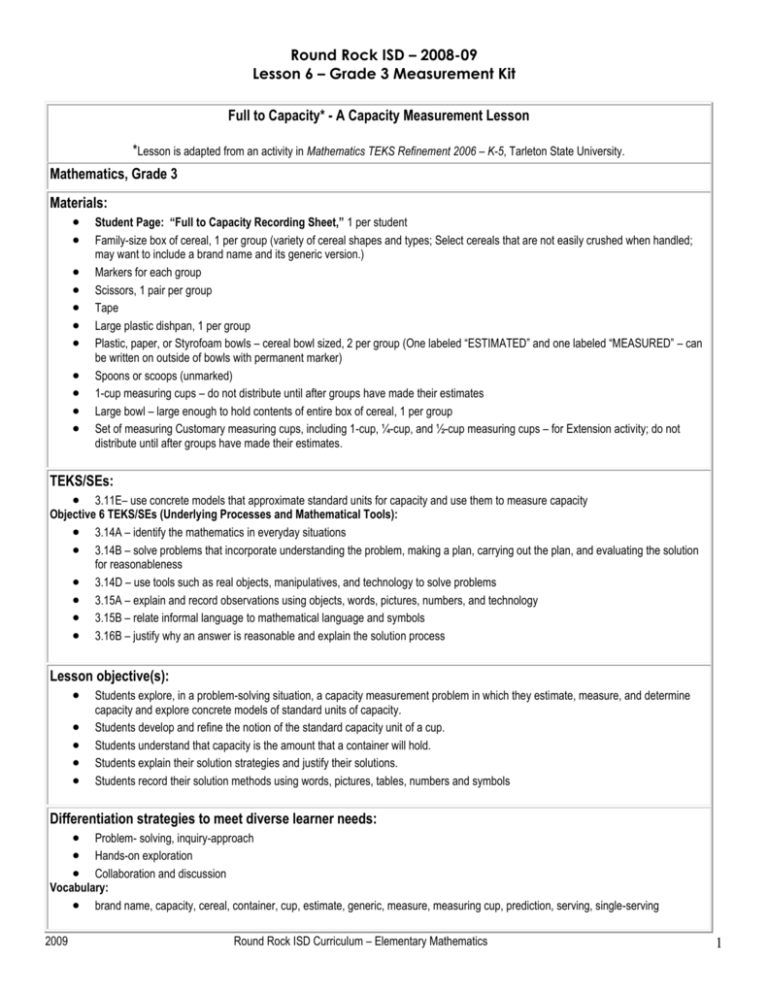Grade3MeasurementKitLesson6FullToCapacity
advertisement

Round Rock ISD – 2008-09 Lesson 6 – Grade 3 Measurement Kit Full to Capacity* - A Capacity Measurement Lesson *Lesson is adapted from an activity in Mathematics TEKS Refinement 2006 – K-5, Tarleton State University. Mathematics, Grade 3 Materials: Student Page: “Full to Capacity Recording Sheet,” 1 per student Family-size box of cereal, 1 per group (variety of cereal shapes and types; Select cereals that are not easily crushed when handled; may want to include a brand name and its generic version.) Markers for each group Scissors, 1 pair per group Tape Large plastic dishpan, 1 per group Plastic, paper, or Styrofoam bowls – cereal bowl sized, 2 per group (One labeled “ESTIMATED” and one labeled “MEASURED” – can be written on outside of bowls with permanent marker) Spoons or scoops (unmarked) 1-cup measuring cups – do not distribute until after groups have made their estimates Large bowl – large enough to hold contents of entire box of cereal, 1 per group Set of measuring Customary measuring cups, including 1-cup, ¼-cup, and ½-cup measuring cups – for Extension activity; do not distribute until after groups have made their estimates. TEKS/SEs: 3.11E– use concrete models that approximate standard units for capacity and use them to measure capacity Objective 6 TEKS/SEs (Underlying Processes and Mathematical Tools): 3.14A – identify the mathematics in everyday situations 3.14B – solve problems that incorporate understanding the problem, making a plan, carrying out the plan, and evaluating the solution for reasonableness 3.14D – use tools such as real objects, manipulatives, and technology to solve problems 3.15A – explain and record observations using objects, words, pictures, numbers, and technology 3.15B – relate informal language to mathematical language and symbols 3.16B – justify why an answer is reasonable and explain the solution process Lesson objective(s): Students explore, in a problem-solving situation, a capacity measurement problem in which they estimate, measure, and determine capacity and explore concrete models of standard units of capacity. Students develop and refine the notion of the standard capacity unit of a cup. Students understand that capacity is the amount that a container will hold. Students explain their solution strategies and justify their solutions. Students record their solution methods using words, pictures, tables, numbers and symbols Differentiation strategies to meet diverse learner needs: Problem- solving, inquiry-approach Hands-on exploration Collaboration and discussion Vocabulary: brand name, capacity, cereal, container, cup, estimate, generic, measure, measuring cup, prediction, serving, single-serving 2009 Round Rock ISD Curriculum – Elementary Mathematics 1 Round Rock ISD – 2008-09 Lesson 6 – Grade 3 Measurement Kit ENGAGEMENT Give each group of students a family size box of cereal (unopened, with the cereal in it). Have the groups carefully open the cereal boxes – but leave the inner bags sealed for now. Tell students to look at the inner flap at the top of the cereal box and find the statement about the package being sold by weight, not contents. Ask a student to read the statement out loud. “This package is sold by weight, not by volume. Some settling of contents may have occurred during shipping and handling.” Ask students to look inside their box – but still leave the inner bag sealed. Are the cereal boxes completely full? Ask: What are the advantages of selling cereal by weight rather than by volume? (Weight is consistent among the different cereals, while volume is not. Grape nuts, for example, are more dense than Rice Krispies, and therefore have much less volume for the same amount of weight.) Discuss: Why aren’t the boxed completely full of cereal? (The bags are filled at the factory but due to the bouncing around during shipping and handling, the cereal settles down into the bottom of the bag. Also, completely full bags and boxes, while environmentally best in a perfect world, end up making for lots of crushed cereal. Crushed cereal leads to upset customers who stop buying the brand. The air in the bag is used to protect the product against shocks.) EXPLORATION – Broken Ruler Part 1: Tell students that they are going to investigate the capacity of their cereal boxes. Discuss the meaning of capacity. Capacity is the amount that a container will hold. Capacity can be measured in units such as cups, pints, quarts, and gallons. Provide groups with markers and dishpans, and follow steps 2 and 3 in the teacher directions for the attached “Full to Capacity” activity from Mathematics TEKS Refinement 2006. (Note: Attachment starts on page 3 of the activity.) Students can use scissors to carefully cut open the cereal bag. Part 2: Provide groups with cereal bowls marked “ESTIMATED” and “MEASURED,” and with unlabeled scoops. Follow step 4 in the teacher directions for the attached activity from Mathematics TEKS Refinement 2006. Part 3: Provide groups with 1-cup measuring cups and follow steps 5 – 8 in the teacher directions for the attached activity from Mathematics TEKS Refinement 2006. Part 4: Hand out the Student Page “Full to Capacity Recording Sheet, and follow steps 9 – 11. Part 5: Follow steps 12 – 16 in the teacher directions for the attached activity from Mathematics TEKS Refinement. BASIC UNDERSTANDINGS: When we measure EXPLANATION Students will explain their thinking and justify their solutions in groups and in whole-class discussion, as well as with tables, diagrams, and written explanations. See activities in “Exploration” and “Elaboration.” ELABORATION – Line It Up! Part 1: 2009 Student groups will have their box of cereal, the two cereal bowls, and an unlabeled scoop. Follow the teacher directions for the “Extensions” on page 8 of the activity from Mathematics TEKS Refinement 2006. (After students have estimated, they will need a selection of measuring cups.) Round Rock ISD Curriculum – Elementary Mathematics 2 Round Rock ISD – 2008-09 Lesson 6 – Grade 3 Measurement Kit EVALUATION Do students use accurate and efficient measuring strategies? Do they have an effective strategy for measuring 2009 Round Rock ISD Curriculum – Elementary Mathematics 3








